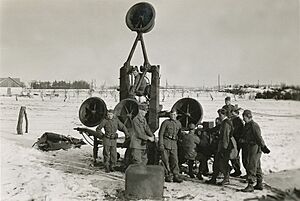Acoustic location facts for kids

Acoustic location is a method of determining the position of an object or sound source by using sound waves. Location can take place in gases (such as the atmosphere), liquids (such as water), and in solids (such as in the earth).
Location can be done actively or passively:
- Active acoustic location involves the creation of sound in order to produce an echo, which is then analyzed to determine the location of the object in question.
- Passive acoustic location involves the detection of sound or vibration created by the object being detected, which is then analyzed to determine the location of the object in question.
Both of these techniques, when used in water, are known as sonar; passive sonar and active sonar are both widely used.
Acoustic mirrors and dishes, when using microphones, are a means of passive acoustic localization, but when using speakers are a means of active localization. Typically, more than one device is used, and the location is then triangulated between the several devices.
As a military air defense tool, passive acoustic location was used from mid-World War I to the early years of World War II to detect enemy aircraft by picking up the noise of their engines. It was rendered obsolete before and during World War II by the introduction of radar, which was far more effective (but interceptable). Acoustic techniques had the advantage that they could 'see' around corners and over hills, due to sound diffraction.
Civilian uses include locating wildlife and locating the shooting position of a firearm.
Images for kids
-
Sound location equipment in Germany, 1939. It consists of four acoustic horns, a horizontal pair and a vertical pair, connected by rubber tubes to stethoscope-type earphones worn by the two technicians left and right. The stereo earphones enabled one technician to determine the direction and the other the elevation of the aircraft.
-
A three-dimensional echo-sounding representation of a canyon under the Red Sea by survey vessel HMS Enterprise
See also
- Acoustic camera
- 3D sound reconstruction
- 3D sound localization
- Sound localization
- Boomerang
- Multilateration
- Acoustic mirror
- Acoustic wayfinding, the practice of using auditory cues and sound markers to navigate indoor and outdoor spaces
- Animal echolocation, animals emitting sound and listening to the echo in order to locate objects or navigate
- Echo sounding, listening to the echo of sound pulses to measure the distance to the bottom of the sea, a special case of sonar
- Gunfire locator
- Human echolocation, the use of echolocation by blind people
- Human bycatch
- Medical ultrasonography, the use of ultrasound echoes to look inside the body
- Sensory substitution




